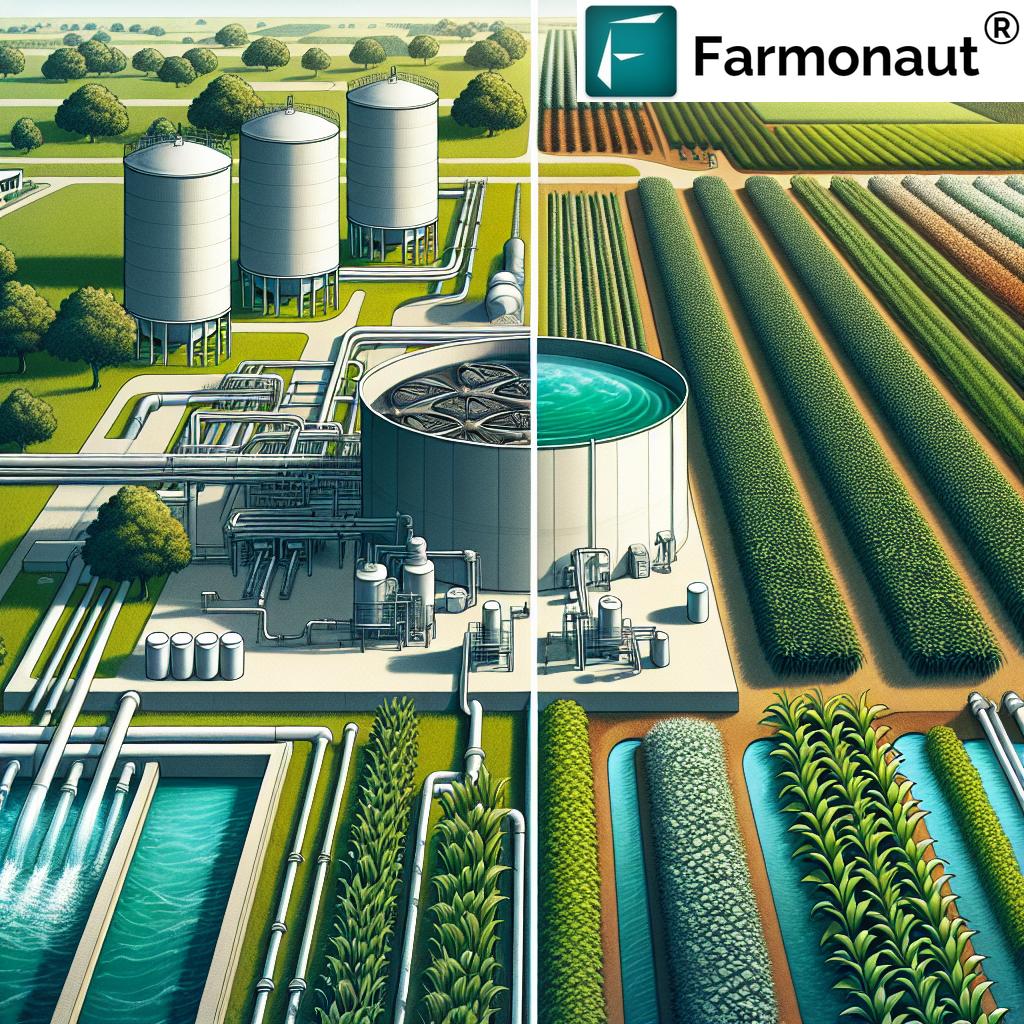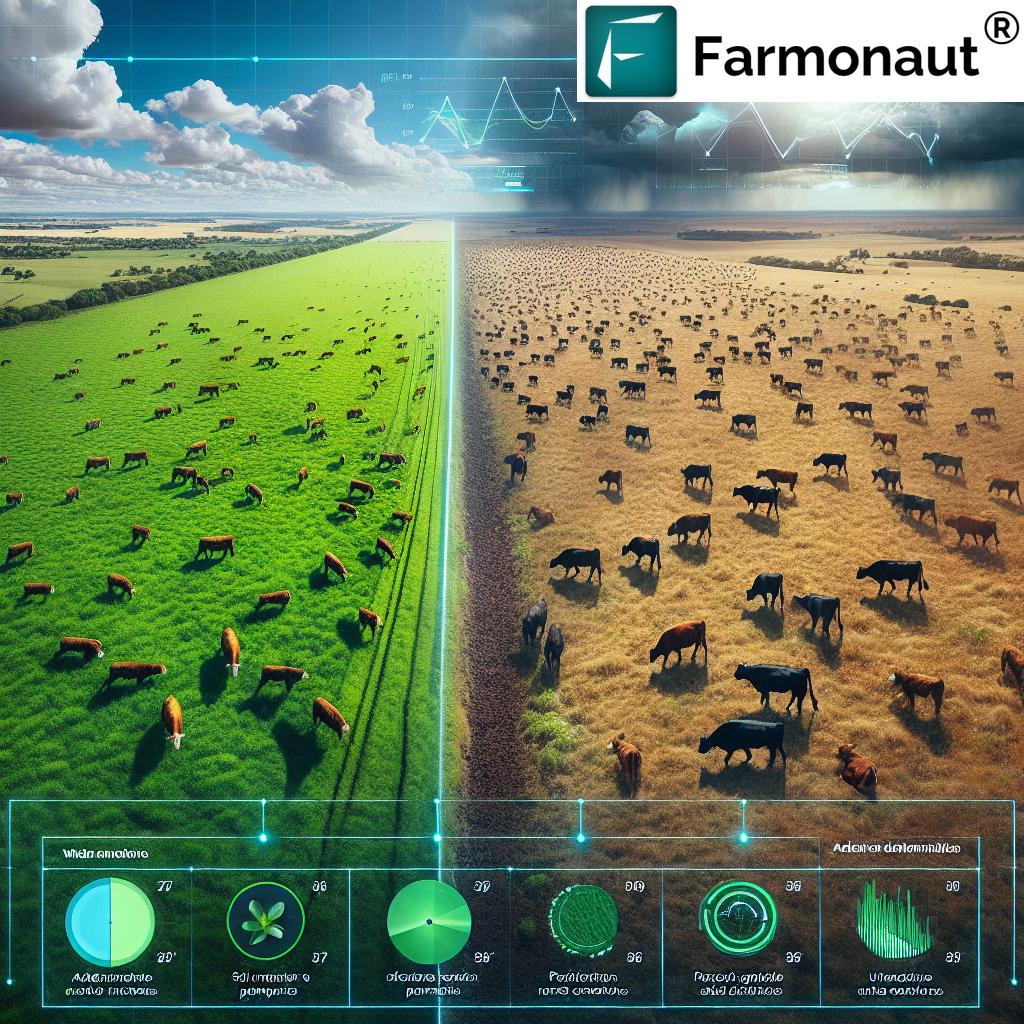Iowa’s Innovative Wastewater Solution: How Osage Transforms Sewage into Sustainable Farming Gold

“Iowa’s innovative wastewater solution reduces utility costs and meets DNR water quality limits ahead of schedule.”
In the heart of America’s Heartland, a quiet revolution is taking place. We’re witnessing a remarkable transformation in the way small communities manage their wastewater, and it’s happening right here in Iowa. The city of Osage, in particular, has become a shining example of how innovative thinking and community collaboration can turn a potential environmental challenge into a golden opportunity for sustainable farming and economic growth.
As we delve into this groundbreaking approach to wastewater treatment in Iowa, we’ll explore how Osage is not only meeting stringent environmental standards but also creating valuable resources for local agriculture. This blog post will take you on a journey through the innovative processes, community benefits, and wider implications of this sustainable wastewater management solution.
The Challenge: Meeting New DNR Water Quality Limits
About four years ago, the Iowa Department of Natural Resources (DNR) notified city officials across the state about new limits on wastewater denitrification. This process, crucial for removing nitrogen from sewage and wastewater to improve water quality, was set to face more stringent regulations starting April 1st. For many small Iowa communities, these new limits posed a significant challenge, potentially leading to costly upgrades and increased utility costs for residents.
However, the city of Osage saw this challenge as an opportunity to innovate. Instead of merely complying with the new regulations, they sought a solution that would not only meet the DNR’s requirements but also benefit the community in multiple ways.
The Innovative Solution: A Collaborative Approach
The key to Osage’s success lies in an unexpected partnership between the city and a local business, Valent BioSciences. This collaboration has resulted in a wastewater treatment process that’s not only effective but also economically and environmentally beneficial.
- Carbon-Rich Waste as a Denitrification Catalyst: After two years of research, it was discovered that the carbon-rich waste from Valent BioSciences’ production of biorational agricultural products could significantly enhance the denitrification process.
- Community Partnership: The city’s wastewater treatment plant, unable to reach the DNR’s goals on its own, found a perfect partner in Valent BioSciences. This partnership has been described by Osage Mayor Steve Cooper as “kind of like a marriage” that’s “gone in the right direction.”
- Cost Reduction: Thanks to Valent BioSciences’ expertise and resources, the city’s wastewater treatment plant operates at a reduced cost, resulting in significant savings for the community.
This innovative approach showcases how small towns can turn environmental challenges into opportunities, fostering both economic growth and environmental protection.
The Denitrification Process: Turning Waste into a Valuable Resource
At the heart of Osage’s wastewater treatment innovation is the denitrification process. This crucial step in wastewater treatment removes nitrogen, a potential pollutant, from sewage and wastewater. Here’s how Osage has revolutionized this process:
- Carbon-Rich Waste Addition: The carbon-rich waste from Valent BioSciences’ production is added to the wastewater treatment process.
- Enhanced Bacterial Activity: This additional carbon source boosts the activity of denitrifying bacteria in the treatment system.
- Efficient Nitrogen Removal: The enhanced bacterial activity leads to more efficient conversion of nitrates into harmless nitrogen gas, which is released into the atmosphere.
- Improved Water Quality: The result is treated water with significantly lower nitrogen levels, meeting and even exceeding the Iowa DNR’s new water quality limits.
This process not only solves the immediate challenge of meeting regulatory requirements but also creates a valuable byproduct: nutrient-rich biosolids that can be used in agriculture.
Benefits for Farmers: Turning Sewage into Agricultural Gold
“Farmers receive bio solids from wastewater treatment containing three essential crop nutrients: nitrogen, phosphorus, and potassium.”
One of the most exciting aspects of Osage’s wastewater treatment innovation is its direct benefit to local farmers. The process doesn’t just clean water; it creates a valuable agricultural resource:
- Nutrient-Rich Biosolids: The treated waste produces biosolids rich in essential crop nutrients, including nitrogen, phosphorus, and potassium.
- Free Fertilizer Alternative: These biosolids are applied to local farmers’ fields, providing a free, sustainable alternative to commercial fertilizers.
- Improved Soil Health: Beyond providing nutrients, these biosolids can improve soil structure and water retention capacity.
- Reduced Fertilizer Costs: By using these biosolids, farmers can significantly reduce their expenditure on commercial fertilizers.
As Brian Lynch, Valent BioSciences facility manager, explains, “In conjunction with local farmers, we apply those biosolids to their fields. Which gives them valuable nitrogen, phosphorus, potassium and a lot of other different minerals, which makes your crops grow much better.”
This approach not only helps farmers but also closes the nutrient cycle, turning what was once considered waste into a valuable resource for sustainable agriculture.

Economic and Environmental Impact
The innovative wastewater treatment approach in Osage isn’t just good for the environment; it’s also having a significant positive economic impact:
- Reduced Utility Costs: Mayor Cooper proudly notes that there’s been only one increase in water utility costs in the past 10 years, a remarkable achievement given the rising costs in many other communities.
- Savings for the City: The implemented practices are saving the city more than $300,000, funds that can be redirected to other community needs.
- Economic Benefits for Farmers: Local farmers benefit from reduced fertilizer costs and potentially improved crop yields.
- Environmental Protection: By effectively removing nitrogen from wastewater, the process helps protect local water bodies from nutrient pollution.
This win-win situation demonstrates how environmental stewardship and economic benefits can go hand in hand when communities think creatively about resource management.
Community Collaboration: The Key to Success
The success of Osage’s wastewater treatment innovation hinges on the strong collaboration between the city and local businesses. This partnership approach offers valuable lessons for other communities facing similar challenges:
- Shared Expertise: By combining the city’s water management knowledge with Valent BioSciences’ technical expertise, Osage created a solution greater than the sum of its parts.
- Resource Sharing: The use of Valent BioSciences’ waste products in the city’s treatment process is a perfect example of industrial symbiosis, where one entity’s waste becomes another’s resource.
- Community Engagement: The involvement of local farmers in utilizing the biosolids creates a broader community buy-in for the project.
- Long-term Vision: Both the city and Valent BioSciences are committed to ongoing collaboration, continually seeking ways to improve and expand their partnership.
As Ertan Hyuseinov, Valent BioSciences plant manager, states, “We are really happy actually to bring those benefits to the whole community.” This sentiment reflects the company’s commitment to being an integral part of the community, embodying the philosophy that true success comes from giving back.
Comparison: Traditional vs. Osage’s Innovative Approach
| Aspect | Traditional Wastewater Treatment | Osage’s Innovative Approach |
|---|---|---|
| Nitrogen Removal Efficiency | Moderate (60-70%) | High (80-90%) |
| Annual Utility Costs | Higher ($500,000+) | Lower (Savings of $300,000+) |
| Compliance with DNR Limits | Struggling to meet | Exceeding expectations |
| Farmer Benefits | Limited | High (Nitrogen, Phosphorus, Potassium-rich biosolids) |
| Environmental Impact | Moderate reduction in water pollution | Significant reduction in water pollution, resource recycling |
The Role of Technology in Sustainable Wastewater Management
While Osage’s innovative approach primarily relies on biological processes and community collaboration, it’s worth noting the increasing role of technology in sustainable wastewater management. For instance, satellite-based monitoring systems, like those provided by Farmonaut, can play a crucial role in understanding land use patterns and their impact on water quality.
Farmonaut’s satellite technology offers valuable insights for agricultural land management, which can indirectly contribute to better wastewater management:
- Monitoring crop health and soil moisture levels to optimize irrigation and reduce runoff
- Tracking land use changes that might affect water quality
- Providing data for precision agriculture, reducing over-application of fertilizers
While not directly involved in Osage’s wastewater treatment process, such technologies complement community-based initiatives by providing data-driven insights for sustainable land and water management.
Looking to the Future: Scaling Up and Spreading Out
The success of Osage’s wastewater treatment innovation opens up exciting possibilities for the future of sustainable water management in Iowa and beyond:
- Replication in Other Communities: Other small towns in Iowa and across the Midwest could potentially adopt similar approaches, tailored to their local industries and resources.
- Continued Research and Improvement: Ongoing research could further enhance the efficiency of the denitrification process and explore new uses for the resulting biosolids.
- Integration with Smart Agriculture: As precision agriculture technologies advance, there could be opportunities to more precisely match biosolid application with specific crop needs, further optimizing resource use.
- Policy Implications: The success of Osage’s approach could influence future water quality regulations, encouraging more flexible, innovation-friendly policies.
As we look to the future, it’s clear that sustainable wastewater management will play an increasingly important role in both environmental protection and agricultural sustainability. Osage’s innovative solution serves as an inspiring example of what’s possible when communities think creatively and collaboratively about resource management.
Conclusion: A Model for Sustainable Community Development
Osage’s innovative approach to wastewater treatment stands as a shining example of how small communities can turn environmental challenges into opportunities for sustainable growth. By thinking creatively, fostering strong community partnerships, and embracing a holistic view of resource management, Osage has not only met stringent water quality standards but has also created a system that benefits farmers, reduces costs for residents, and protects the environment.
This success story offers valuable lessons for communities across Iowa and beyond:
- The power of local partnerships in solving complex environmental challenges
- The potential for turning waste into valuable resources
- The importance of considering both environmental and economic impacts in community planning
- The role of innovation in meeting and exceeding regulatory requirements
As we face growing environmental challenges and tightening regulations, Osage’s approach provides a roadmap for sustainable community development. It shows that with creativity, collaboration, and commitment, small towns can lead the way in creating sustainable solutions that benefit both people and the planet.
The transformation of sewage into “farming gold” in Osage, Iowa, is more than just a local success story. It’s a beacon of hope and a model for sustainable wastewater management that could inspire communities around the world to rethink their approach to waste, resources, and environmental stewardship.
FAQs
- Q: How does Osage’s wastewater treatment process differ from traditional methods?
A: Osage’s process incorporates carbon-rich waste from a local business to enhance the denitrification process, making it more efficient and cost-effective than traditional methods. - Q: What are the main benefits for farmers from this wastewater treatment innovation?
A: Farmers receive nutrient-rich biosolids containing nitrogen, phosphorus, and potassium, which can be used as a free, sustainable alternative to commercial fertilizers. - Q: How much money is the city of Osage saving with this new approach?
A: The implemented practices are saving the city more than $300,000 annually. - Q: Can this approach be replicated in other communities?
A: Yes, while the specific details may vary, the general approach of community collaboration and turning waste into resources can be adapted by other communities. - Q: How does this innovation help meet Iowa DNR water quality limits?
A: The enhanced denitrification process removes more nitrogen from wastewater, allowing Osage to meet and exceed the DNR’s new water quality limits.
Earn With Farmonaut: Earn 20% recurring commission with Farmonaut’s affiliate program by sharing your promo code and helping farmers save 10%. Onboard 10 Elite farmers monthly to earn a minimum of $148,000 annually—start now and grow your income!
















